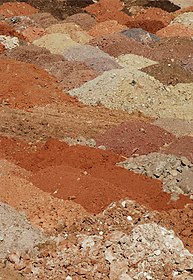
Soil color is often the most visually apparent property of soil. While color itself does not influence the behavior or practical use of soils,[1] it does indicate important information about the soil organic matter content, mineralogy, moisture, and drainage.[2]
Soil can display a wide range of colors including brown, red, yellow, black, gray, white, and even blue or green, and vary dramatically across landscapes, between the various horizons of a soil profile, and even within a single clod of soil.[1]
The development and distribution of color in soil results from chemical and biological weathering, especially redox reactions. As the primary minerals in soil parent material weather, the elements combine into new and colorful compounds. Soil conditions produce uniform or gradual color changes, while reducing environments result in disrupted color flow with complex, mottled patterns and points of color concentration. Sometimes, a distinct change in color within a soil profile indicates a change in the soil parent material or mineral origin.[3]
- ^ a b Brady, Nyle C.; Weil, Ray R. (2010). Elements of the nature and properties of soils (3rd ed.). Upper Saddle River, N.J. ISBN 978-0-13-501433-2. OCLC 276340542.
{{cite book}}: CS1 maint: location missing publisher (link) - ^ Owens, P. R.; Rutledge, E. M. (2005). Encyclopedia of soils in the environment. Daniel Hillel, Jerry L. Hatfield (1st ed.). Oxford, UK: Elsevier/Academic Press. ISBN 0-12-348530-4. OCLC 52486575.
- ^ Gardiner, Duane T.; Miller, Raymond W. (2008). Soils in our environment (11th ed.). Upper Saddle River, N.J.: Pearson/Prentice Hall. ISBN 978-0-13-219104-3. OCLC 85018836.